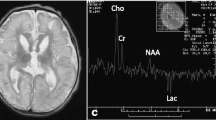Abstract
Isolated sulphite oxidase deficiency (ISOD) is a rare autosomal recessive inborn error of metabolism, which may present at birth with intractable seizures (often of prenatal onset) and severe neurological abnormalities. In infants who survive, lens dislocation may occur from 8 weeks of age. The neuropathological findings in ISOD are similar to those seen in severe perinatal asphyxia. We describe two siblings with ISOD born to healthy non-consanguineous parents. The first child presented within 48 h of birth with poor feeding and seizures. He died from septicaemia on day 20 of life. The clinical presentation, neuroradiology and autopsy suggested a diagnosis of severe hypoxic ischaemic encephalopathy with a low recurrence risk. The second child presented with seizures within an hour of birth. She lived for 16 months during which time she failed to make developmental progress and continued to experience intractable seizures. Her neuroradiology was similar to her brother’s. A diagnosis of ISOD was suggested from high urinary S-sulphocysteine in the second child and confirmed by the absence of sulphite oxidase activity in skin fibroblast culture. The diagnosis has enabled the couple to access prenatal testing in a subsequent pregnancy. Conclusion:Isolated sulphite oxidase deficiency is an autosomal recessive condition which may mimic ischaemic encephalophathy. The disorder should be considered in all cases of intrauterine seizures, intractable seizures in the newborn period and infants with clinical and radiological features of ischaemic encephalophathy, especially when no obvious insult can be determined.



Similar content being viewed by others
Abbreviations
- ISOD :
-
isolated sulphite oxidase deficiency
References
Brown GK, Scholem RD, Croll HB, Wraith JE, McGill JJ (1989) Sulfite oxidase deficiency: clinical, neuroradiologic, and biochemical features in two new patients. Neurology 39: 252–257
Carragher FM, Kirk JM, Steer C, Allen J, Dorche C (1999) False negative thiosulphate screening test in a case of molybdenum cofactor deficiency. J Inherit Metab Dis 22: 842–843
Chan KY, Li CK, Lai CK, Ng SF, Chan AYW (2002) Infantile isolated sulphite oxidase deficiency in a Chinese family: a rare neurodegenerative disorder. Hong Kong Med J 8: 279–282
Duran M, Aarsen G, Fokkens RH, Nibbering NM, Cats BP, de Bree PK, Wadman SK (1981) 2-Mercaptoethanesulfonate-cysteine disulfide excretion following the administration of 2-mercaptoethanesulfonate—a pitfall in the diagnosis of sulfite oxidase deficiency. Clin Chim Acta 111: 47–53
Edwards MC, Johnson JL, Marriage B, Graf TN, Coyne KE, Rajagopalan KV, MacDonald IM (1999) Isolated sulfite oxidase deficiency—review of two cases in one family. Ophthalmology 106: 1957–1961
Johnson JL, Rajagopalan KV, Lanman JT, Schutgens RBH, van Gennip AH, Sorensen P, Applegarth DA (1991) Prenatal diagnosis of molybdenum cofactor deficiency by assay of sulphite oxidase activity in chorionic villus samples. J Inherit Metab Dis 14: 932–937
Johnson JL, Rajagopalan KV, Renier WO, Van der Burgt I, Ruitenbeek W (2002) Isolated sulfite oxidase deficiency: mutation analysis and DNA-based prenatal diagnosis. Pren Diagn 22: 422–436
Mann G, Kirk JM (1994) Antibiotic interference in urinary thiosulphate measurements. J Inherit Metab Dis 17: 120–121
Rabier D, Chadefaux-Vekemans B, Oury JF, Aupetit J, Bardet J, Gasquet M, Merhand E, Parvy P, Kamoun P (1996) Gestational age-related reference values for amniotic fluid amino acids: a useful tool for prenatal diagnosis of aminoacidopathies. Pren Diagn 16: 623–628
Reist M, Marshall KA, Jenner P, Halliwell B (1998) Toxic effects of sulphite in combination with peroxynitrite on neuronal cells. J Neurochem 71: 2431–2438
Rupar CA, Gillett J, Gordon BA, Ramsay DA, Johnson JL, Garrett RM, Rajagopalan KV, Jung JH, Bacheyie GS, Sellers AR (1996) Isolated sulfite oxidase deficiency. Neuropediatrics 27: 299–304
Salman MS, Ackerley C, Senger C, Becker L (2002) New insights into the neuropathogenesis of molybdenum cofactor deficiency. Can J Neurol Sci 29: 91–96
Slot HM, Overweg-Plandsoen WCG, Bakker HD, Abeling NG, Tamminga P, Barth PG, Van Gennip AH (1993) Molybdenum-cofactor deficiency: an easily missed cause of neonatal convulsions. Neuropediatrics 24: 139–142
Touati G, Rusthoven E, Depondt E, Dorche C, Duran M, Heron B, Rabier D, Russo M, Saudubray JM (2000) Dietary therapy in two patients with a mild form of sulphite oxidase deficiency: evidence for clinical and biological improvement. J Inherit Metab Dis 23: 45–53
Van der Klei-van Moorsel JM, Smit LM, Brockstedt M, Jakobs C, Dorche C, Duran M (1991) Infantile isolated sulphite oxidase deficiency: report of a case with negative sulphite test and normal sulphate excretion. Eur J Pediatr 150: 196–197
Author information
Authors and Affiliations
Corresponding author
Additional information
E. Hobson and S. Thomas contributed equally to this paper
Rights and permissions
About this article
Cite this article
Hobson, E.E., Thomas, S., Crofton, P.M. et al. Isolated sulphite oxidase deficiency mimics the features of hypoxic ischaemic encephalopathy. Eur J Pediatr 164, 655–659 (2005). https://doi.org/10.1007/s00431-005-1729-5
Received:
Accepted:
Published:
Issue Date:
DOI: https://doi.org/10.1007/s00431-005-1729-5




